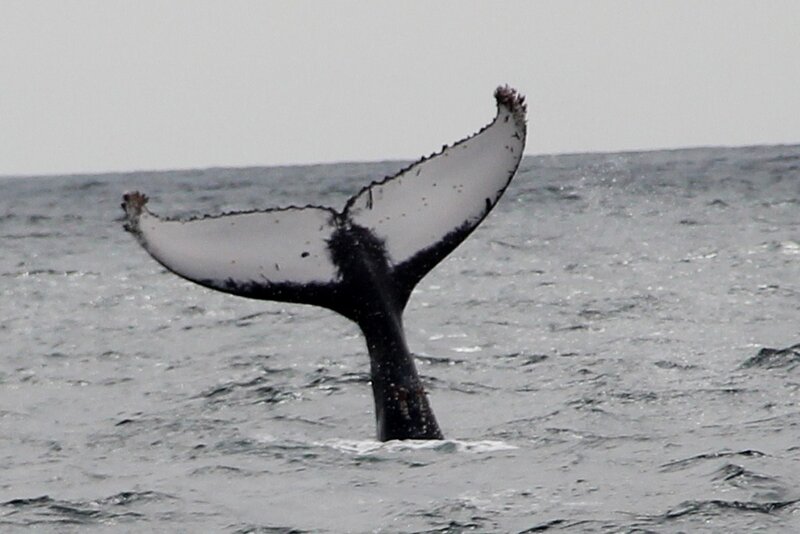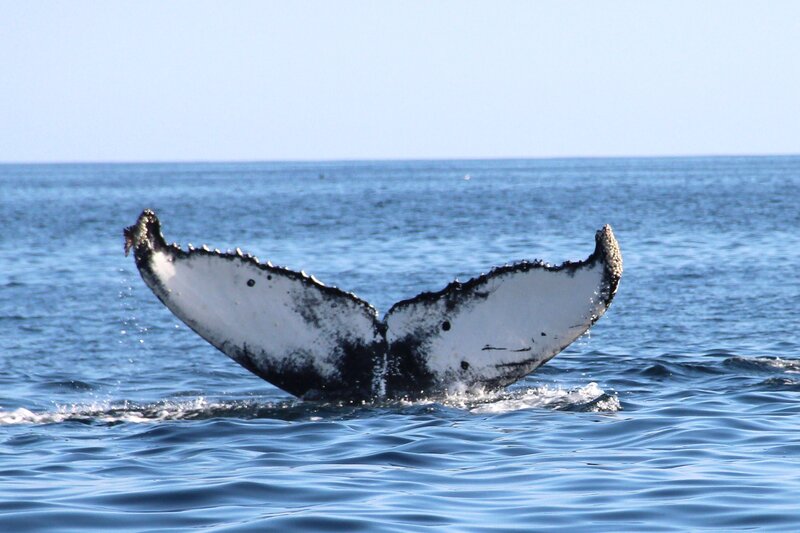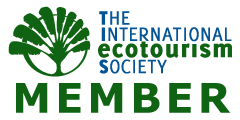Irish Humpback Whales Season 2023 West Kerry Ireland SW HBIRL67 From Dingle to Donegal and (Tromso) Norway
Irish Humpback Whale HBIRL24
"Spot" (showing one original spot on left ventral fluke)
photo: Britta Wilkens 31.05.2014

Irish Humpback Whale HBIRL47
Dingle Bay, West Kerry, Ireland SW
photo: Britta Wilkens 19.04.2017

Humpback Whales - Ireland - Dingle Sept 15th 2016 [Trevor Read]
Irish Humpback Whales Season 2023 - West Kerry Ireland SW
So far, the 2023 humpback whale watching season off the west coast of Ireland has thrown up quite a few anomalies and surprises, all the way from the south and west coast of Cork to the west coast of Donegal, with most sightings for 2023 whale watching season so far recorded off the coasts of Mayo, Sligo and Donegal and fewer recorded off the coasts of Cork, Kerry, Clare and Galway.
This reverses the pattern seen in the most recent ten to fifteen years when most sightings were recorded off West Kerry and West Cork throughout the summer months and humpback whale sightings from the NW were rare. Of course, this should not be surprising as the west coast of Mayo - the closest part of Ireland to the continental shelf edge - west of the Inishkea Islands, and Donegal Bay were hotspots for whales in the bad old whaling days but very few "catches" of humpbacks (6) were recorded back then - over 100 yrs. ago - in comparison to the combined catches of blue whales (124); fin whales (592); sei whales (91); sperm whales (63); and right whales (18) recorded in the period 1908 - 1922 - excluding the Great War period - by the three whaling companies that operated west of the Inishkea islands over that period - Arranmore Whaling Co.; Blacksod Whaling Co.; Akties Nordhavel / Blacksod Whaling Co.
So, what is going on?
Pattern of Humpback Whale Sightings in Ireland 2023 Whale Watching Season as recorded by IWDG [Irish Whale and Dolphin Group].
First of all, the season started off with a bang, with 3 individual humpback whales - HBIRL122; HBIRL123; HBIRL124 - all new entries to the Irish Humpback Whale Catalogue - recorded on March 2nd, 2023 off the South Kerry coast in Kenmare Bay (1) and St. Finian's Bay (2).
It looked like we were in for a bumper 2023 Irish whale watching season here in South and West Kerry! But apart from one sighting from Slea Head, Co. Kerry in mid-March and a sighting of 2 individuals off the Stags Rocks, Co. Cork in mid-April and one sighting in Mullaghmore, Co. Sligo on April 30th it was a very quiet start to the Irish Humpback Whale Watching Season.
Throughout May three animals were consistently seen off Erris Head, Co. Mayo and Broadhaven Bay, Co. Mayo and the focus for humpback whale sighting had definitely shifted to the northwest. On May 24th three animals were spotted by Colin Barnes off Toe head, Co. Cork and the author does not have access to any info whether or not these were the same animals that were popping up in the northwest, or three different animals.
June was a fine month - our summer so far - and most sightings of individual animals only, were made in Broadhaven Bay, Co. Mayo; Donegal Bay and Mullaghmore, Co. Sligo, but nothing like the humpback whale activity that we had seen in recent summers off the coasts of West Kerry and West Cork.
Throughout July the humpback whale sighting pattern was continued with sightings mainly in Donegal Bay, with four animals recorded on July 17th and three animals on July 24th.
The latest recorded sighting is for three animals recorded in Donegal Bay on August 1st, 2023 so the pattern appears to be continuing.
Some Ole (Humpback) Friends seem to prefer Mayo, Sligo and West Donegal to West Kerry and West Cork for Irish Humpback Whale Season, 2023
Photo identification evidence seems to suggest that some of the humpback whales that have been sighted in Mullaghmore, Co. Sligo; Broadhaven Bay, Co. Mayo and especially Donegal Bay are individuals known as HBIRL24; HBIRL47; and HBIRL67 who formerly frequented Dingle Bay and the Blaskets sea area on a regular and recurring basis.
We first saw HBIRL24 - whom we named as "Spot" from one (originally) little dark spot on the right inside of his left ventral tail fluke, although he has now acquired many more - way back in 2014 and we wrote up the wonderful encounter we had with him in our website blog:
www.marinetours.ie/wildlife-log.html in an article entitled:
- A Humpback Whale called "Spot" and a talisman called "Micky Finn" -
where we described Spot's general behaviour as nothing short of "amazyballs!" especially the way he waved his pectoral fin in the air as if calling us over and then proceeded to do the backstroke with his long pectoral fins. By all accounts he is living up to his reputation in West Donegal. This is eleven years in a row that he has been spotted in Irish waters since first identified by Nick Massett in Dingle Bay in 2013. We spotted him on one of our Afternoon Dolphin & Whale Watching Tours on May 31, 2014; September 22, 2015; August 13 & 18, 2016 and August 1, 2017 so there is always a possibility that we nay see him again over the next few weeks as humpback whales are known to have site fidelity as long as there is sufficient forage fish for them to eat.
HBIRL47 is also a common visitor to the waters of West Kerry and the Blaskets and spent a lot of the summer of 2017 (April) and 2020 (July 11; August 10 &11 & 24; September 21) in Dingle Bay. So, he is another visitor that we may expect shortly if there are sufficient sprat shoals left after the uncontrolled and unregulated commercial fishing effort for this non-quota species over the last number of years by large Big Fishing pelagic trawlers in Irish inshore waters, bays and estuaries.
HBIRL 67 is another very interesting character and was first identified by Blasket Islands Eco Marine Tours as a baby off Slea Head on April 24th, 2016. She was subsequently spotted that year by our whale watching tour boat M.V. "Blasket Princess" on May 5 and June 7; in 2017 on August 25 and September 27; in 2019 on August 24 & 25 and in 2020 on September 18, so this is another animal that we hope to spot shortly if local food stocks are sufficient.
She was part of the iconic footage for the documentary "Wild Ireland - The Edge of the World" in which Colin Stafford Johnson rows a naomhóg (a currach or tarred canvas covered canoe) below Slea Head, Co. Kerry and beside HBIRL 67 who was then only a baby. She has also been spotted off West Kerry every year since then and also, surprisingly, off Tromso in northern Norway, inside the Arctic circle which is a long way from her potential breeding grounds either off the Cabo Verde islands off West Africa or on the Silver Banks in the Dominican Republic in the Caribbean,
Our "Irish" humpback whales are very well travelled and let us hope that they keep coming back to the waters of West Donegal, West Kerry and West Cork so that we get a chance to get a short glimpse of them in their natural habitat before they continue on their migratory route to the breeding grounds
HBIRL102 is the latest re-sighting of an already catalogued humpback whale off Donegal and the author does not have access to data about this animal to date, as we have no personal sightings of this animal by our whale watching tour boat M.V. "Blasket Princess" as we have for the other animals listed above, but hopefully, shortly, he will pay a visit to Dingle Bay and the Blaskets and we can get a few photo id shots of him then and we can check out his / her / their individual characteristics.
Possible Reasons for Change in Foraging Habits of Humpback Whales in Ireland 2023
1. Back when Blasket Islands Eco Marine Tours first started doing our eco tours and whale watching trips about fifteen years ago it was more or less accepted that we got our humpback whales here in West Kerry mid-August to September and hopefully that will be the way again this year! Then, for the last ten years or so it was a bit of a lottery whether or not the humpback whales would be here or in West Cork during the Summer months. Some years they would come early to one area first and then the following year it would be the other way around, but sightings were consistently very plentiful in both areas during the summer months, with the exception of this year. So, what has changed?
Obviously the first thing to think about is the food source. As we say to our visitors onboard when they ask us if they will see whales - "We will only see them if they are here, and they will only be here if there is good feeding of sand eels and / or sprat so that they can build up body condition for their long migratory voyage to the breeding grounds where they will not eat for over two months and live off their body fat reserves". Amazingly, no proper, comprehensive, scientific study has been undertaken by either BIM [Bord Iascaigh Mhara] - because they are cetaceans and not fish, even though they need fish to survive (!) -or the Marine Institute - who have the relevant resources - or the Dept. of Agriculture who are in charge of allocation of fish quotas and TAC [Total Allowable Catch] and oversee the health of the marine ecosystem (supposedly) or the relevant environmental NGO - IWDG [Irish Whale & Dolphin Group] into their food source while foraging in Irish waters and this is absolutely essential in order to protect and conserve this food source.
Ireland has also signed up to various Conventions including the Convention for the Protection of Migratory Animals [Bonn Convention] and the Protection of Endangered Species and is thereby obliged as a party State to the various Conventions to protect and conserve this food source, when scientifically identified and quantified. the irony is that we know what the food source is but until it is actually scientifically identified and quantified, we do not know its conservation status. In the meantime, we believe that the Precautionary Principle should be applied and all commercial fishing for sand eels and sprat within the 12mile limit in Irish waters should be banned until an accurate assessment is made of this food source of cetaceans (whales, dolphins, porpoises) seabirds (including puffins, Manx shearwaters, kittiwakes, terns, petrels etc.) and even other commercial fish stocks.
Sometimes (Always?) in Ireland, the common sense approach is the road less travelled.
Therefore, if the humpback whales are talking with their flukes, the best food resources of sand eels and / sprat are currently off the northwest coast and not in the waters of West Kerry and West Cork where forage fish stocks have been depleted by unregulated and under reported commercial fishing. Hopefully, this will change shortly, but it remains to be seen.
2. Climate Change is obviously another factor and with ocean seawater temperature rising, some species of fish are moving further north in order to stay within their own preferred temperature range. Mackerel and cod have mover further north and species like hake are now very plentiful in Irish waters. Bluefin tuna can be seen regularly jumping in Dingle Bay in August and September and shoals of anchovy are reported on the southwest. Trigger fish are now seen regularly by divers and in pots by lobster fishermen.
Because of the lack of any comprehensive and inclusive study of sand eel and sprat vertical and spatial migration patterns, It is not known if these stocks are moving north towards the shores of Donegal. The presence or absence of humpback whales and fin whales off the coasts of West Kerry and West Cork this August / September / October should give some indication of whether these forage fish populations are still in a healthy state, or, as prewarned by many concerned people and NGOs. the lack of regulation and inclusion for protection under the Wildlife Act for this non-quota species will eventually lead to the collapse of the whole marine ecosystem which depends on their existence as the base of the marine food chain, for their survival.
During the recent freakish, warm ocean-seawater plume this summer off the coast of Ireland when seawater temperatures rose to 18 and even up to 20 degrees Celsius in some sheltered bays, including Ventry Harbour for two or three weeks, the average surface seawater temperature in June from the south coast of Cork right up to Malin Head in Donegal was 17 degrees Celsius within inshore waters. We are not sure yet what effects this had on sand eel populations and sprat shoals but it is reasonable to assume that this vast increase in normal seasonal seawater temperatures of about 4 degrees Celsius, over a prolonged period of time of about four weeks, must have had a detrimental effect on the base of the food chain which will only become apparent in cetacean, bird and (commercial) fish populations in the years to come.
Visual observation evidence from the puffin population on the outer Blasket Islands of Inishvickillaun and Inish na Bró seem to show that not as many puffins as normal (hardly any on some days) were seen returning to their burrows with sand eels in their beaks to feed their young. If you combine the collapse in the sand eel population with the constant disturbance by speedboats of the breeding puffin population there, contrary to the Wildlife Act, then the future collapse of the puffin population in the Blasket Islands SPA [Special Protected Area] is a looming threat, in tandem with the total collapse of the Harbour porpoise population in the Blasket islands SAC [Special Area of Conservation].
What a really bad joke, wildlife protection, conservation and management is in Ireland.
3. We often wonder if there were humpbacks passing by north and west of the Blaskets before Blasket Islands Eco Marine Tours actually started looking for them around 2009? It was more or less a happy coincidence that around the same time that we diversified from fishing and ferrying to doing eco tours around the outer Blasket Islands, local man Nick Massett of the IWDG also started land-based watches for cetaceans. It was a big event then to spot a Minke whale (!) and I still remember the first humpback whale (calf) that we spotted one mile south of Gob an Oileáin in 2010 which later unfortunately dead-stranded in Galway. As we grew in experience of optimum areas and depth contour lines in which to spot humpback whales, Nick also perfected his method of land-based whale watching and often directed us onto sightings from the land.
But the question remains unanswered. Did the increased dedicated whale watching effort by land and by sea merely pick up what existing cetacean activity was already there; or were we just lucky - serendipity or lucky happance - that when we started our eco tours, whales started to get more plentiful around the Blaskets, as they have now off Mayo, Sligo and Donegal?
I am inclined to think that it was the latter.
The same questions and answers can be applied to the present whale watching season in Donegal. The fact remains that the sighting of "Spot" off Rossnowlagh by a group of surfers on a boating trip, was the first sighting of a humpback whale in Donegal in 25 years and not necessarily the result of an increase in whale and dolphin watching tour boats. Also, the animals seen there this year, have all previously frequented the waters of West Kerry and West Cork so there is obvious displacement, probably due to better forage fish resources in the northwest and diminished forage fish resources in the southwest.
We can only hope that in the next few weeks there will be an improvement in the sprat stocks along the southwest coast which will entice humpback whales to forage here again and that they do not join the long list of species that have been lost from or in danger of extinction in the Blasket islands so-called European designated SAC [Special Area of Conservation] and SPA [Special Protected Area] including the over-wintering flock of Greenland white-fronted geese (gone); breeding Arctic terns (gone); Harbour porpoises (on a trajectory towards extinction in the SAC designated for protection of Harbour porpoises (and grey seals - whose population has exploded and may be contributing in part to the disappearance of the harbour porpoises); and possibly puffins - unless proper management and conservation plans are put in place before it is too late.
Common ecological sense and local knowledge and environmental concern should not always be the road less travelled.....................
Log of the Watching Tour Boat M.V. "Blasket Princess"
Michael [Mick] Sheeran 01.08.2023

























